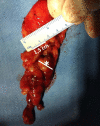Cyclic ACTH-secreting thymic carcinoid: a case report and review of the literature
- PMID: 33844892
- PMCID: PMC10522176
- DOI: 10.20945/2359-3997000000346
Cyclic ACTH-secreting thymic carcinoid: a case report and review of the literature
Abstract
Cyclic Cushing's syndrome (CS) due to thymic carcinoid is a rare disorder. We report a case of cyclic CS due to ectopic adrenocorticotropic hormone (ACTH)-secreting atypical thymic carcinoid tumor and reviewed similar cases published in the literature. Our patient had hypercortisolemia lasting approximately one month, followed by normal cortisol secretion, with relapse one year later. Histopathology revealed an atypical ACTH-positive thymic carcinoid. Ectopic CS can be derived from atypical thymic carcinoids, which can be aggressive tumors with early relapse, suggesting that this type of tumor probably needs aggressive treatment.
Conflict of interest statement
Disclosure: no potential conflict of interest relevant to this article was reported.
Figures



Similar articles
-
Ectopic Cushing's syndrome due to adrenocorticotropic hormone secreting atypical thymic carcinoid tumor.North Clin Istanb. 2018 Aug 7;6(1):85-88. doi: 10.14744/nci.2018.53244. eCollection 2019. North Clin Istanb. 2018. PMID: 31180388 Free PMC article.
-
ACTH-dependent Hypercortisolemia in a Patient with a Pituitary Microadenoma and an Atypical Carcinoid Tumour of the Thymus.Medicina (Kaunas). 2019 Nov 27;55(12):759. doi: 10.3390/medicina55120759. Medicina (Kaunas). 2019. PMID: 31783507 Free PMC article.
-
Carcinoid tumors of the thymus and Cushing's syndrome: Clinicopathologic features and current best evidence regarding the cell of origin of these unusual neoplasms.Ann Diagn Pathol. 2019 Feb;38:71-79. doi: 10.1016/j.anndiagpath.2018.11.006. Epub 2018 Nov 22. Ann Diagn Pathol. 2019. PMID: 30502716
-
Cushing's syndrome due to adrenocorticotropic hormone-secreting metastatic neuroendocrine tumor of unknown primary origin: a case report and literature review.Hormones (Athens). 2022 Mar;21(1):147-154. doi: 10.1007/s42000-021-00316-z. Epub 2021 Sep 3. Hormones (Athens). 2022. PMID: 34478059 Free PMC article. Review.
-
Bronchial Carcinoid Tumour as a Rare Cause of Cushing’s Syndrome in Children: A Case Report and Review of Literature.J Clin Res Pediatr Endocrinol. 2020 Nov 25;12(4):340-346. doi: 10.4274/jcrpe.galenos.2019.2019.0156. Epub 2020 Jan 3. J Clin Res Pediatr Endocrinol. 2020. PMID: 31898446 Free PMC article. Review.
References
-
- Meinardi JR, Wolffenbuttel BH, Dullaart RP. Cyclic Cushing's syndrome: a clinical challenge. Eur J Endocrinol . 2007;157(3):245–254. - PubMed
-
- Lacroix A, Feelders RA, Stratakis CA, Nieman LK. Cushing's syndrome. Lancet . 2015;386(9996):913–927. - PubMed
-
- Young J, Haissaguerre M, Viera-Pinto O, Chabre O, Baudin E, Tabarin A. Management Of Endocrine Disease: Cushing's syndrome due to ectopic ACTH secretion: an expert operational opinion. Eur J Endocrinol . 2020;182(4):R29–R58. - PubMed
-
- Rindi G, Klimstra DS, Abedi-Ardekani B, Asa SL, Bosman FT, Brambilla E, et al. A common classification framework for neuroendocrine neoplasms: an International Agency for Research on Cancer (IARC) and World Health Organization (WHO) expert consensus proposal. Mod Pathol . 2018;31(12):1770–1786. - PMC - PubMed
Publication types
MeSH terms
Substances
LinkOut - more resources
Full Text Sources
Medical
